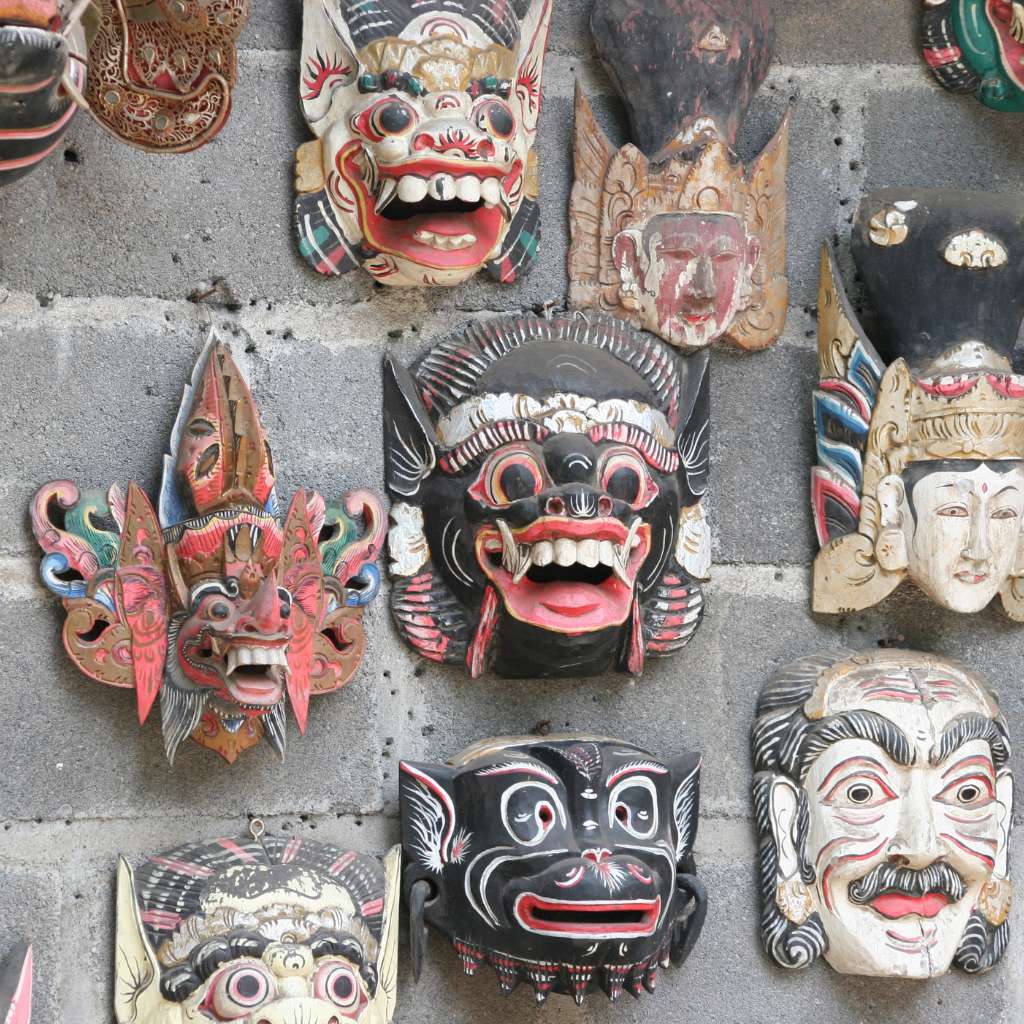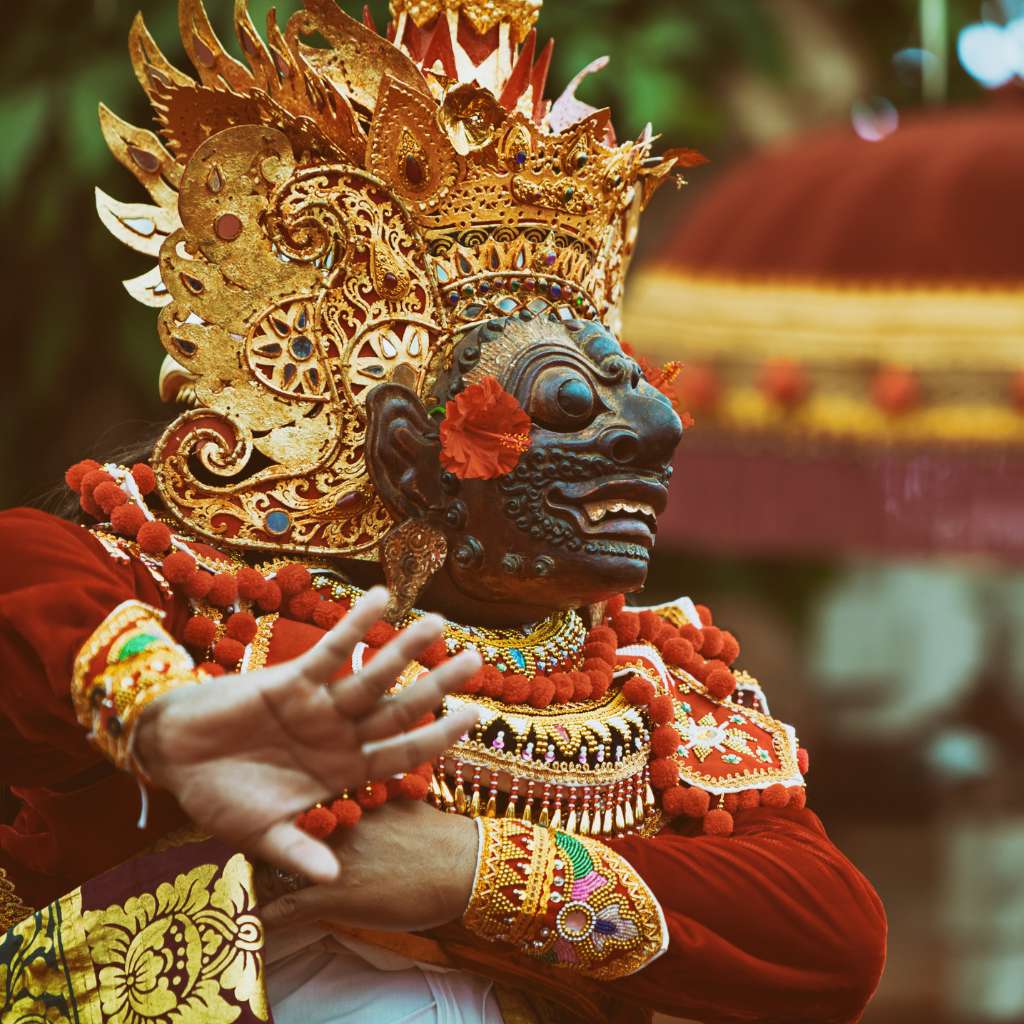Behind Balinese Mask: History, Symbolism, and Meaning

More than just an exquisite piece of artwork, Balinese masks holds deeper meanings, and masterpieces connected to culture, religion and history. These masks are part of almost every ritual, performance, art and life incorporated by the people of the island. In this article, we will try to see their historical significance, types, symbols, craftsmanship, and where to find these artifacts.
1. The Historical Roots of the Balinese Mask

The tradition of Balinese masks dates back centuries, rooted in the island’s complex religious and cultural history. Influenced by both animism and Hinduism, Balinese masks originally emerged as sacred items in religious ceremonies, where they were believed to house spirits or deities. Over time, masks became symbolic representations of various aspects of Balinese mythology, allowing stories and moral lessons to be shared through performance and art.
In particular, Bali’s adoption of Hinduism in the 14th century intensified the spiritual importance of masks. Masks became essential in temple ceremonies and rituals, where they were believed to connect the people of Bali with gods and spirits. Today, masks remain central to Balinese culture, preserving ancient traditions while continually evolving in form and function.
2. Types of Balinese Masks and Their Functions

There are several types of Balinese masks, each with its own purpose and meaning. The main categories include:
Barong Masks
Barong masks represent the spirit of the righteous. These masks are used during the Barong dance, which depicts the eternal warfare between good and evil.
Rangda Masks
Barong’s evil and chaotic counterpart. Rangda masks are worn for performances that show the fight against evil forces.
Topeng Masks
Characters like Kings, clowns, or other historical figures are donned in these masks during the Topeng dance, which makes the storytelling of Bali richly diverse.
Ceremonial Masks
Many religious ceremonies need ceremonial masks that are put on the face of a deity seal or an ancestral spirit to bridge the gap between mortals and other-worldly beings.
3. Symbolism of Common Balinese Masks

Balinese masks are rich in symbolism, with each mask representing different aspects of life, spirituality, and morality. Some of the most iconic masks include:
Barong Mask

The Barong mask symbolizes the spirit of good and protection. Often depicted as a lion-like creature, Barong is considered a guardian deity that protects villages from harm. The Barong dance, performed in traditional ceremonies, dramatizes the eternal battle between good (Barong) and evil (Rangda).
Rangda Mask

Rangda, a fearsome witch, symbolizes chaos and destruction. As the embodiment of evil, Rangda is both feared and respected in Balinese culture. The dramatic contrast between the Barong and Rangda masks represents the balance of opposing forces, a key principle in Balinese spirituality.
Topeng Masks

The Topeng dance uses a series of masks to tell historical or mythological stories, each mask representing a different character or archetype. Some common figures in Topeng include wise kings, clowns, and noble heroes. These masks often have exaggerated expressions, allowing performers to convey personality and emotion without words.
4. The Spiritual and Cultural Meaning of Balinese Masks

In Bali, masks are much more than artistic creations—they serve as vessels for spiritual connection. During religious ceremonies, it is believed that the wearer of a sacred mask can channel the spirit it represents, allowing gods or ancestral spirits to communicate with the people.
The use of Balinese masks also reflects the island’s belief in balance, known as Rwa Bhineda. In Balinese culture, opposites coexist harmoniously, good cannot exist without evil, and life cannot exist without death. The dramatic battles between characters like Barong and Rangda symbolize this balance, reminding people of the need to respect both sides of existence.
Masks also play a role in strengthening community bonds. During temple festivals, villagers gather to watch mask performances, reaffirming their shared beliefs and traditions. This communal aspect of Balinese masks helps preserve cultural identity across generations.
5. The Craftsmanship Behind Balinese Masks

Creating a Balinese mask is a highly skilled craft, typically passed down through generations of artisans. Traditional mask-makers, or undagi tapel, often work with specific types of wood, such as pule or hibiscus, believed to hold spiritual energy. Each mask is meticulously carved and painted, with every detail holding symbolic significance.
The crafting process is also spiritual. Mask-makers often follow ritual practices to maintain the mask’s sacredness, such as fasting or praying before beginning a new piece. The facial expressions, colors, and embellishments on each mask are thoughtfully chosen to convey the character’s unique energy. For example, bright colors often represent joyful or positive spirits, while darker tones are used for malevolent beings.
6. Where to Buy a Balinese Mask?

If you’re interested in purchasing a Balinese mask as a souvenir, it’s essential to buy from reputable artisans who respect the cultural significance of these creations or you can get it in a traditional market such as Ubud Traditional Market. Decorative masks are widely available, but it’s important to remember that sacred masks are meant solely for religious use. Respecting this cultural boundary helps preserve the authenticity and spirituality of Balinese masks.
Balinese masks are a captivating blend of art, spirituality, and cultural identity. From their ancient origins to their role in contemporary Bali, these masks embody the island’s unique worldview, where the sacred and the earthly come together. As both beautiful artifacts and powerful symbols, Balinese masks continue to inspire awe, reminding us of Bali’s rich heritage and its ongoing dialogue with the spiritual world. Whether worn in a temple ceremony or displayed in a dance, each mask tells a story—one that speaks to the heart of Balinese culture.
People Also Read:
This article is made by:

TRIANG VILLAS ADMIN
We offer stunning Bali villas for short or long stays, manage your property seamlessly, and help you find your dream Bali villas. With Triang Villas Bali, every stay feels like home.






